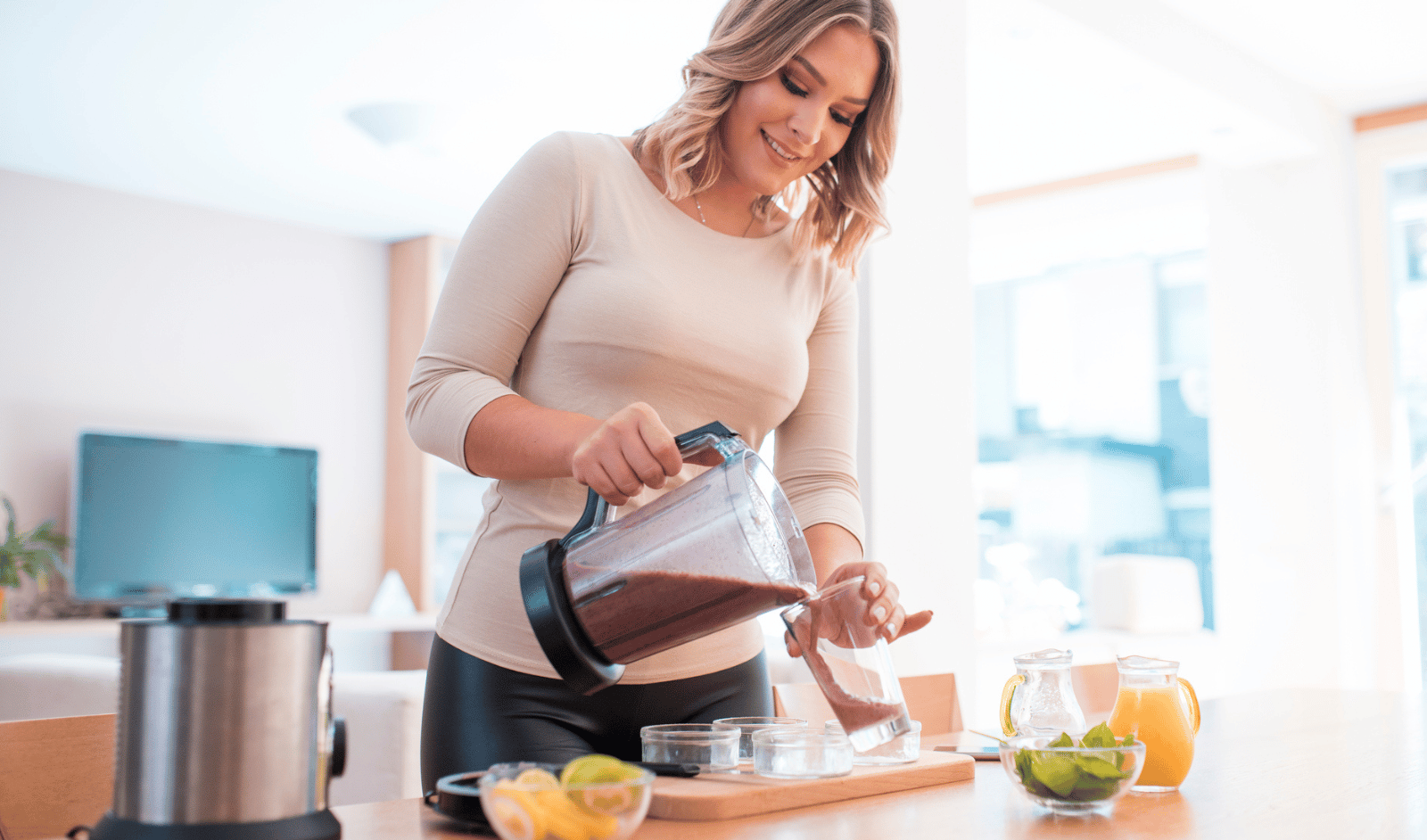Are Smoothies Healthy? Are They Good For Weight Loss?
Can a fiber-rich, no-sugar-added smoothie that’s loaded with fresh fruit, vegetables, and other whole foods help you lose weight? Probably not. Find out why.

Smoothies made purely of whole fruits and vegetables, and if desired, a little soymilk or nonfat dairy, are wonderfully healthy and nutritious. But if you’re trying to lose weight, be careful.
Are Smoothies Healthy?
You’ve packed into your blender all kinds of fresh, whole foods like strawberries, blueberries, mango, kale, and mint.
What could be wrong?
Nothing, actually, until you turn on the blender.
For losing weight, there’s one major problem with smoothies – all smoothies. They’re liquids.
Less Satiety
Consistently, researchers have found that calories in liquid form have less satiety than calories in solid form. What is satiety? It’s the opposite of hunger. Satiety is getting out of hunger. Satiety is also a measure of how long you stay full after eating.
Foods that provide the highest satiety for the fewest calories will help you lose weight and keep it off because they do not force you to live with chronic hunger. Pritikin has been teaching healthy living skills for more than 40 years.
The satiety level of liquids is slim to none, meaning, you don’t compensate for the calories you drink by eating less food. For example, if you drink a smoothie (let’s say it’s 150 calories) before or with a meal, you’re unlikely to compensate by eating 150 fewer calories of food at that meal or at your next meal.
How To Lose Weight
Bottom Line: If weight loss is your goal, steer clear of any beverage with calories, from soft drinks to sugary teas to smoothies to fruit juices. Liquid calories, no matter their source, will not curb your appetite as well as solid foods do.
So, rather than pulverizing your fruits and veggies with a blender, enjoy them whole. Peel a banana. Break open a bag of baby carrots. Swirl strawberries into a dish of nonfat Greek yogurt. Keep a big bowl of fresh fruit on the kitchen counter. Get in the habit of taking fruit and veggies wherever you go.
And watch that bathroom scale plummet.

Learn More About Pritikin
Meal Replacement Shakes/Smoothies
There is one exception to the above. Research has found that in outpatient medically-monitored programs, meal replacements in liquid form, such as protein-fruit-vegetable shakes, are beneficial for weight loss. They are quick and simple and may replace a true junk food breakfast.
There is no question that people can lose weight on such shakes/smoothies, but their efficacy for long-term weight control is debatable.
For permanent weight-loss success, an exercise and eating approach like Pritikin is your best bet. That’s because the Pritikin Eating Plan focuses on foods that are not only healthy but also provide the highest satiety for the fewest calories.
High-satiety/low-calorie foods include whole vegetables, whole fruits, beans, potatoes, yams, and cooked whole grains such as whole-wheat pasta and brown rice, and moderate amounts of nonfat dairy and lean meat.
Make-Your-Own Smoothies
As you know, smoothies are popular these days, so popular that sales of make-your-own-smoothie items like blender machines and bags of frozen fruit have risen, say market watchers.
Nicely, there are truly healthy choices, like frozen fruit combinations that have no added sugar or juice. (Look for Ingredient Lists that list only fruits and/or vegetables, nothing else.) To make your smoothie, simply blend with soymilk or nonfat dairy milk. That’s it.
Good brands of frozen fruit-and-veggie combinations include Dole Fruit & Veggies Blends, Wyman’s of Maine, Earthbound Farm Organic Smoothie Kickstart, and many store brands.
Don’t Be Fooled
And everywhere you go, from supermarkets to fast food restaurants to coffee shops, ready-to-drink smoothie choices abound.
Do put on your label-reading glasses, however. Many commercially-produced smoothies, though promoted as super nutritious, are anything but.
Here are four examples of smoothies that will likely do more damage than good to your waistline and health.
“No Sugar Added!”
Some bottles of smoothies boast on the front label that they have “no added sugar.” While that may be true, do turn the bottle around. Check out the Nutrition Facts label and Ingredient List. One 15-ounce bottle has a whopping 320 calories – yes, that’s about 50 calories per sip.
Plus, the naturally occurring sugar from one brand isn’t coming from a whole lot of whole fruit. It’s mainly from apple juice concentrate, which is highly refined and processed and hardly different from sugar or high fructose corn syrup.
“Rich In Fiber!”
A large proportion of the fiber in some of these commercial smoothies is from refined fibers like dextrin and inulin, not fruit puree. That’s cause for concern, say nutrition researchers, because processed fibers probably do not have the same benefits as naturally-fiber-rich fruits, vegetables, beans, and whole grains.
Products like these smoothies, packed with refined sugars and refined fibers, may raise fasting triglyceride levels, promote weight gain, and increase insulin resistance. They will no doubt also raise blood sugar levels in people with diabetes.
And though home-blending your fruits and vegetables is better than buying these store-bought, refined-fiber smoothies, it’s likely not as beneficial as eating your fruits and veggies whole, especially if you’re trying to peel off pounds.
The impact of blended fiber on satiety is almost surely less than if the same fiber is consumed as a solid food.
“3-¾ Servings of Fruit!”
Striving to cash in on Americans’ efforts to get more servings of fruit and vegetables in their diet, many food manufacturers have trumpeted that a really simple way to consume multiple fruit-and-veggie servings is to drink a smoothie. One, for example, advertises that its 15-ounce bottle has 3-¾ servings of fruit.
Technically, that’s correct. The U.S. Department of Agriculture says that a half cup (4-ounce) serving of fruit juice counts as one serving of fruit.
But what they doesn’t tell you is that the USDA also recommends that most of the fruit Americans eat should be whole fruit, not fruit juice.
“How Many Servings?”
This is an old trick, but sadly, a lot of people keep getting tricked. Many 15- or 16-ounce smoothies list calories at about 80 or 90 calories, and people often think, “Well, that’s not terrible.”
But those 80 or 90 calories are for one 8-ounce serving. Drink the entire bottle (which most of us do), and we’ve downed about 160 calories. That’s more calories than you’d get from a can of coke.
Bottom Line | Are Smoothies Healthy?
Some smoothies, especially the ones you make at home from whole fruits and vegetables, are high in vitamins, minerals, and many other beneficial nutrients.
But for losing weight, smoothies tend not to be a good choice because they’re liquids. Calories in liquid form have less satiety, or hunger-curbing power, than calories in solid form.
Your best choice for losing weight is whole vegetables and whole fruit.
